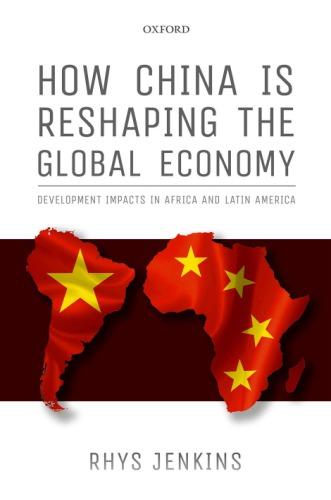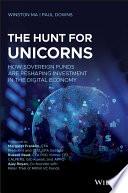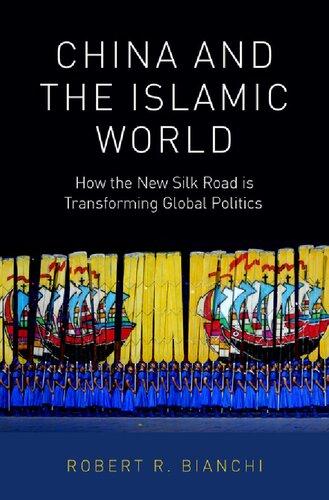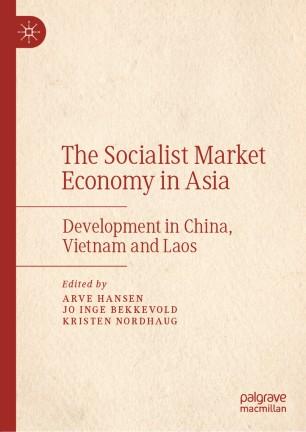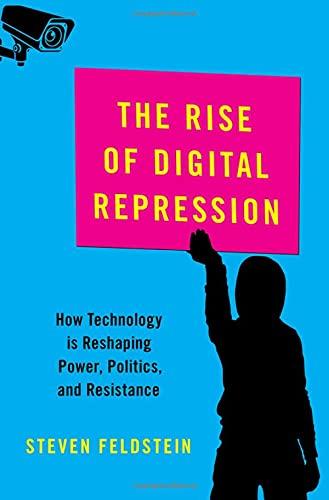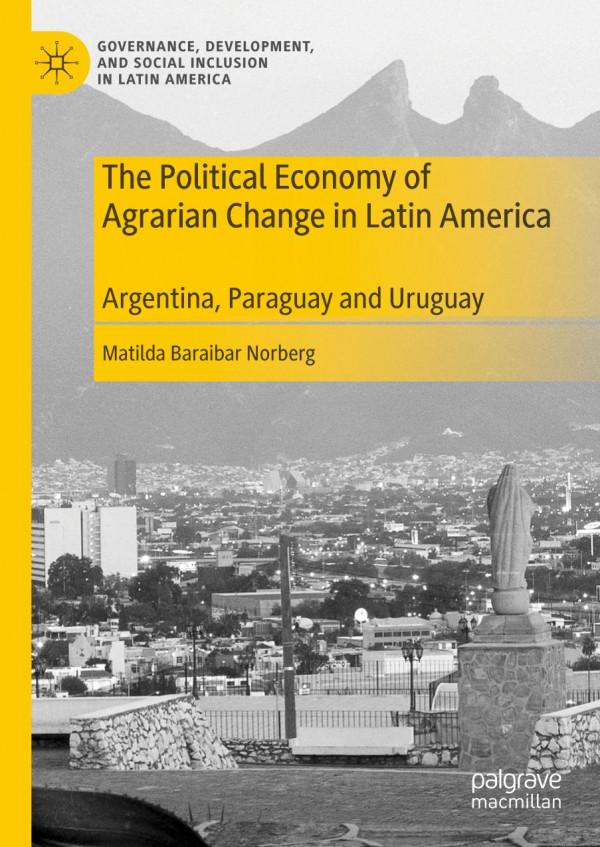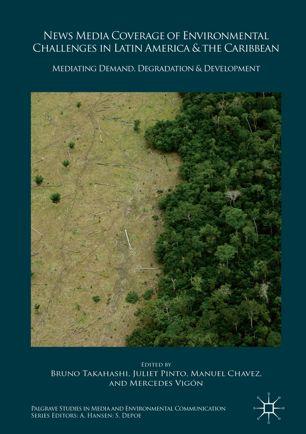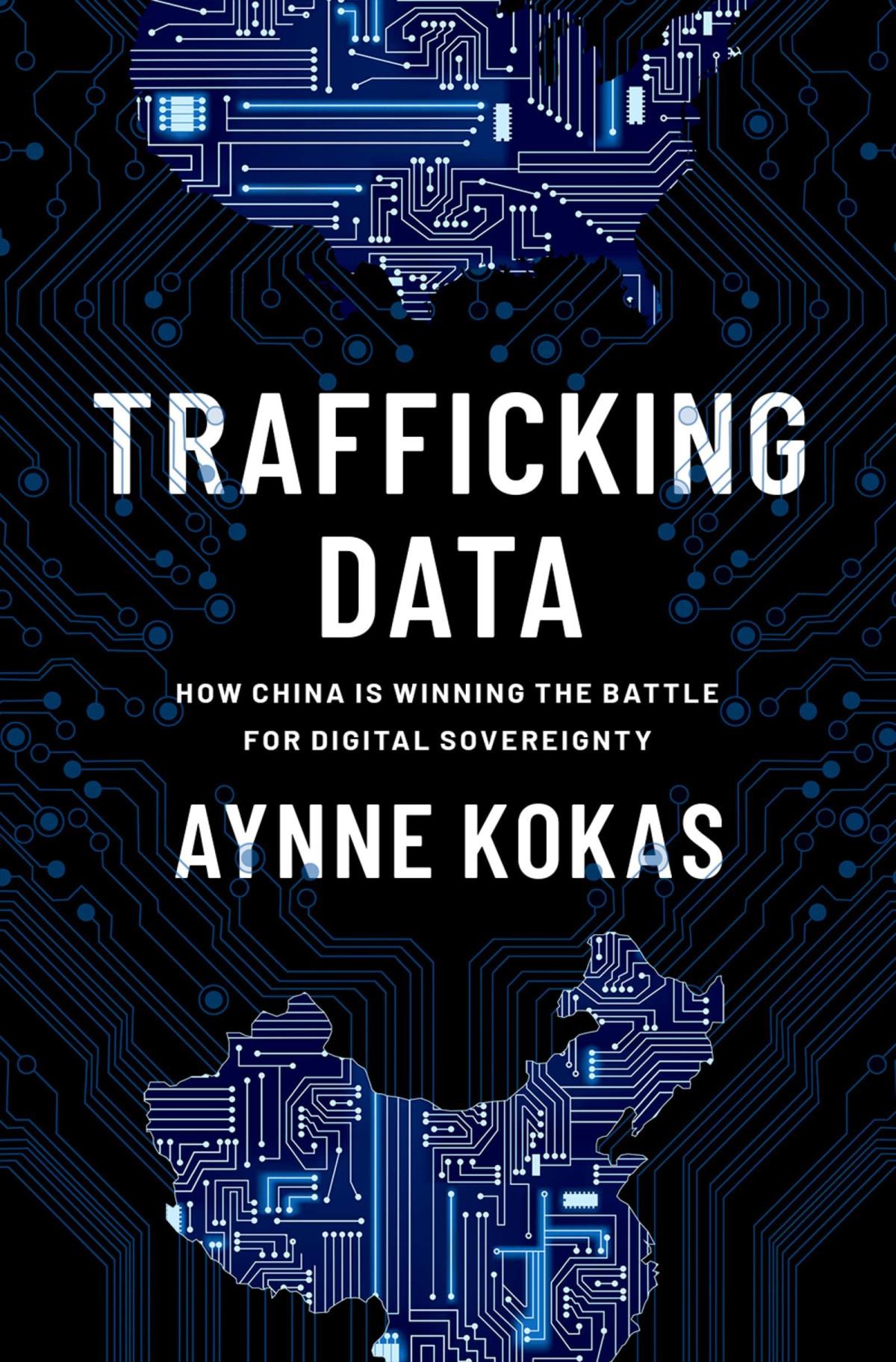How China Is Reshaping The Global Economy: Development Impacts In Africa And Latin America 1st Edition Rhys Jenkins
Visit to download the full and correct content document: https://ebookmass.com/product/how-china-is-reshaping-the-global-economy-develop ment-impacts-in-africa-and-latin-america-1st-edition-rhys-jenkins/
More products digital (pdf, epub, mobi) instant download maybe you interests ...
The Hunt for Unicorns : How Sovereign Funds Are Reshaping Investment in the Digital Economy 1st Edition
Winston Ma
https://ebookmass.com/product/the-hunt-for-unicorns-howsovereign-funds-are-reshaping-investment-in-the-digitaleconomy-1st-edition-winston-ma/
China and the Islamic World: How the New Silk Road is Transforming Global Politics Robert Bianchi
https://ebookmass.com/product/china-and-the-islamic-world-howthe-new-silk-road-is-transforming-global-politics-robert-bianchi/
The Socialist Market Economy in Asia: Development in China, Vietnam and Laos 1st ed. Edition Arve Hansen
https://ebookmass.com/product/the-socialist-market-economy-inasia-development-in-china-vietnam-and-laos-1st-ed-edition-arvehansen/
The Rise of Digital Repression: How Technology is Reshaping Power, Politics, and Resistance 1st Edition
Steven Feldstein
https://ebookmass.com/product/the-rise-of-digital-repression-howtechnology-is-reshaping-power-politics-and-resistance-1stedition-steven-feldstein/
The Socialist Market Economy in Asia: Development in China, Vietnam and Laos Arve Hansen
https://ebookmass.com/product/the-socialist-market-economy-inasia-development-in-china-vietnam-and-laos-arve-hansen/
The Political Economy of Agrarian Change in Latin America: Argentina, Paraguay and Uruguay 1st ed. 2020 Edition Matilda Baraibar Norberg
https://ebookmass.com/product/the-political-economy-of-agrarianchange-in-latin-america-argentina-paraguay-and-uruguay-1sted-2020-edition-matilda-baraibar-norberg/
News Media Coverage of Environmental Challenges in Latin America and the Caribbean: Mediating Demand, Degradation and Development 1st ed. Edition Bruno Takahashi
https://ebookmass.com/product/news-media-coverage-ofenvironmental-challenges-in-latin-america-and-the-caribbeanmediating-demand-degradation-and-development-1st-ed-editionbruno-takahashi/
Trafficking Data: How China Is Winning the Battle for Digital Sovereignty Aynne Kokas
https://ebookmass.com/product/trafficking-data-how-china-iswinning-the-battle-for-digital-sovereignty-aynne-kokas/
Resisting Violence: Emotional Communities in Latin America 1st Edition Morna Macleod
https://ebookmass.com/product/resisting-violence-emotionalcommunities-in-latin-america-1st-edition-morna-macleod/
HowChinaisReshapingtheGlobalEconomy HowChinaisReshaping theGlobalEconomy DevelopmentImpactsinAfrica andLatinAmerica RhysJenkins
GreatClarendonStreet,Oxford,OX26DP, UnitedKingdom
OxfordUniversityPressisadepartmentoftheUniversityofOxford. ItfurtherstheUniversity’sobjectiveofexcellenceinresearch,scholarship, andeducationbypublishingworldwide.Oxfordisaregisteredtrademarkof OxfordUniversityPressintheUKandincertainothercountries ©RhysJenkins2019
Themoralrightsoftheauthorhavebeenasserted
FirstEditionpublishedin2019
Impression:1
Allrightsreserved.Nopartofthispublicationmaybereproduced,storedin aretrievalsystem,ortransmitted,inanyformorbyanymeans,withoutthe priorpermissioninwritingofOxfordUniversityPress,orasexpresslypermitted bylaw,bylicenceorundertermsagreedwiththeappropriatereprographics rightsorganization.Enquiriesconcerningreproductionoutsidethescopeofthe aboveshouldbesenttotheRightsDepartment,OxfordUniversityPress,atthe addressabove
Youmustnotcirculatethisworkinanyotherform andyoumustimposethissameconditiononanyacquirer
PublishedintheUnitedStatesofAmericabyOxfordUniversityPress 198MadisonAvenue,NewYork,NY10016,UnitedStatesofAmerica BritishLibraryCataloguinginPublicationData
Dataavailable
LibraryofCongressControlNumber:2018949663
ISBN978–0–19–873851–0
Printedandboundby CPIGroup(UK)Ltd,Croydon,CR04YY
LinkstothirdpartywebsitesareprovidedbyOxfordingoodfaithand forinformationonly.Oxforddisclaimsanyresponsibilityforthematerials containedinanythirdpartywebsitereferencedinthiswork.
Tomygrandchildren, Tom,Mat,andKit, whowillexperiencetheconsequencesofChina’s re-emergenceasaglobaleconomicpower.
PrefaceandAcknowledgements I firstbecameinterestedintheimpactofChina’seconomicgrowthonthe GlobalSouthin2004,whenIwascommissionedbytheUKDepartmentfor InternationalDevelopment(DFID)toprepareapaperforaconferencein BeijingatthelaunchoftheInter-AmericanDevelopmentBank’sstudyof theopportunitiesandchallengesthattheemergenceofChinapresentedfor LatinAmericaandtheCaribbean(Devlinet.al.,2006).Thiswasthe firsttime thatIhadvisitedChina,anditbeganaperiodwhenmyresearchwasmainly focussedonquestionsposedbytheriseofChina.
Muchofmypreviousworkhadbeenabouttheimpactofglobalization, startingwithstudiesoftransnationalcorporationsandtradeliberalization inLatinAmericaandthenextendingtoworkontheenvironmentaland socioeconomicimplicationsofglobalizationinLatinAmerica,SouthAfrica, Vietnam,andMalaysia.
Bythemid-2000s,itwasalreadybecomingclearthatthedramaticgrowthof Chinaanditsre-incorporationintotheglobaleconomywasakeyfeatureof globalizationinthetwenty-firstcentury.TheaccessionofChinatotheWorld TradeOrganizationin2001sparkedanumberofstudieslookingatthelikely impactsthatthiswouldhaveinboththeNorthandtheSouth.
MyowninterestdevelopedthroughfurtherstudiesforDFIDontheimpacts ofChinaonAsia,Africa,andLatinAmerica,carriedoutwithmycolleague ChrisEdwards.Iwasalsoinvolvedinanetworkofscholarswhostudiedthe impactsoftheAsianDrivers(ChinaandIndia)ontheGlobalSouthand publishedspecialissuesofthe IDSBulletin and WorldDevelopment onthis theme(Kaplinsky,ed.,2006:KaplinskyandMessner,eds.,2008).
SomeofmysubsequentresearchontheimpactofChinaonLatinAmerica, onBrazil,andonSouthAfricawasfundedbytheUKEconomicandSocial ResearchCouncil(ESRC),1 andthisallowedmetogointogreaterdepthonthe impactsofChinaonspecificcountries.Iworkedwithanumberofcolleagues ontheseprojectsandIamparticularlygratefulfortheircontributions.They includeJonathanBarton,EnriqueDussel-Peters,AndrésLopez,Alexandrede
1 ESRCgrantnumbersRES-165-25-005;RES-238-25-0006;andES/1035125/1.
FreitasBarbosa,andLawrenceEdwards.Iwasalsofortunatetoreceivea LeverhulmeResearchFellowshipthatenabledmetostartworkonthisbook.
AsIdelveddeeperintotheimpactsofChinaonLatinAmericaandthe Caribbean(LAC)andSub-SaharanAfrica(SSA),IbecameawarethatIneeded toobtainabetterunderstandingofthedriversofChinesegrowthandglobal projection.Thus,althoughthebookwasoriginallyplannedasastudyofthe impactsofChinaonthetworegions,Irealizedthatitneededtobeginwith developmentsinChina.AlthoughIdonotclaimtobeanexpertonChinese economicdevelopment,IhopethatPartIofthebookwillprovidethereader withsufficientbackgroundtomakesenseoftheimpactsonLACandSSA.
IamveryconsciousthatonelimitationIfacedinwritingthebookisthat IdonotreadChinese.Thismayhaveledtotheunderrepresentationofsome pointsofview.IhavetriedwhereverpossibletorefertoofficialChinese documentsthatareavailableinEnglishandtotheworkofChineseacademics thathasbeentranslatedintoorpublishedinEnglish.However,thisprobably doesnotdofulljusticetotherangeofChineseviewsonLACandSSA,and itmaymeanthatChineseperspectivesthataremorecriticalarenotfully represented.Ontheotherhand,Ihavedrawnonarangeofsourcesfromboth LACandSSAtoensurecoverageofviewsfromwithinbothregions.
Iwouldliketothankcolleagueswhohavereadandcommentedonpartsof thisbookfortheirinvaluablefeedback.TheyincludeEnriqueDussel-Peters, ChrisEdwards,RaphieKaplinsky,BereketKebede,DiegoSánchez-Ancochea, andJohnThoburn.MichaelAbou-Sleimanprovidedresearchassistancein puttingtogetherthedatabaseandcarryingouttheeconometricanalysisthat isreportedinthebook.Finally,SallySutton’seditingworkonthemanuscript helpedputitintoacoherentandpresentableform.Iacknowledgealltheir contributions,whileacceptingultimateresponsibilityforthecontentsand anyerrorsthatremain.
ListofFigures xi
ListofTables xiii
ListofBoxes xv
ListofAcronyms xvii
Introduction:China’sRe-emergenceasaGlobalEconomicPower1
PartI.ChinaandtheGlobalEconomy
1.TheTransformationoftheChineseEconomy13
2.TheWorkshopoftheWorld33
3.AVoraciousDragon?ChinaandGlobalCommodityMarkets52
4.GoingGlobal:ChineseFirmsAbroad72
5.TheWorld’sWallet?China’sRoleinGlobalFinance92
PartII.ChinaandSub-SaharanAfrica
6.China’sEconomicExpansioninSub-SaharanAfrica113
7.China’sEconomicImpactsonSub-SaharanAfrica149
8.Social,Political,andEnvironmentalImpacts inSub-SaharanAfrica183
PartIII.ChinaandLatinAmericaandtheCaribbean
9.China’sEconomicExpansioninLatinAmericaand theCaribbean223
10.China’sEconomicImpactsonLatinAmerica254
11.Social,Political,andEnvironmentalImpactsinLatinAmerica284
12.AComparativePerspectiveonChina’sinvolvement inSub-SaharanAfricaandLatinAmericaandtheCaribbean321 13.Conclusion337
ListofFigures 2.1.China’sShareofWorldManufacturingValueAdded(MVA)and WorldManufacturedExports,1980–2014(%)33
2.2.ShareofChina’sManufacturedExportsbyTechnologyLevel,1995–201445
3.1.Indexofcommoditypricesinconstant2010US$(2010=100)57
4.1.Chinesestockandannual flowofoutwardFDIandturnoverof contractedprojectsfulfilled,1982–2014(US$billion)74
4.2.Geographicaldistributionofvalueofcompletedprojects,1998–2000 and2013–1577
5.1.China’sforeignassets,2004–15(US$billion)95
6.1.China’stradewithSSA,1995–2015(US$billion)115
6.2.SharesofdifferentproductsinimportsfromSSA,2013–15116
6.3.Chineseoutwardforeigndirectinvestment(OFDI)stocksand flows inSSA,2003–15(US$million)118
6.4.ChinesecontractsinSSA,2003–15(US$million)120
6.5.SectoraldistributionofthevalueofChineseprojectcontractsinSSA, 2005–16121
6.6.ChineseOfficialFinancialFlowstoSSA,2000–14(US$million)123
7.1.ShareofChineseimportsinapparentconsumptionofmanufactured goodsinselectedcountries,2000–10161
9.1.China’stradewithLatinAmerica,1995–2015(US$billion)225
9.2.SharesofdifferentproductsinimportsfromLatinAmerica,2013–15226
9.3.ChineseOFDIinLatinAmerica,2003–15(US$million)228
9.4.SectoraldistributionofthevalueofChineseprojectcontractsinLAC, 2005–16231
9.5.ChineseloansandprojectsinLatinAmerica,2005–15(US$million)231
10.1.China’sshareinapparentconsumptionofmanufacturesinselected LatinAmericancountries,2000–13262
11.1.CoincidenceofvotingbetweenLatinAmerica,China, andtheUS,2000–15299
ListofTables 0.1.ExamplesofpossibleimpactsofChinaondevelopingcountries6
3.1.China’ssignificanceincommoditymarkets,2000,2015(%)55
6.1.DeterminantsofSino-SSAeconomicrelations143
A6.1.SignificanceofeconomicrelationswithChinabycountryinSSA148
8.1.Percentageofexportsofwoodproductsathighriskofillegality, bydestination,2013211
A8.1.EffectsofvoiceandaccountabilityonSino-SSAeconomicrelations217
A8.2.EffectsofcontrolofcorruptiononSino-SSAeconomicrelations217
A8.3.EffectofpoliticalstabilityonSino-SSAeconomicrelations218
A8.4.ImpactofeconomicrelationswithChinaongovernance219
9.1.KeyactorsinSino-LACeconomicrelations234
9.2.DeterminantsofSino-LACeconomicrelations,2002–15248
A9.1.SignificanceofeconomicrelationswithChinabycountryinLAC253
10.1.IndustrieswiththehighestlevelofChineseimportpenetration263
11.1.EstimatedimpactoftradewithChinaonmanufacturing employmentinLatinAmerica,1995–2011286
11.2.SharesofLatinAmericantradewithChinaandtheUS,2015(%)298
A11.1.DeterminantsofvotingcoincidencewithChina318
12.1.SummaryofChina’smajorimpactsonSSAandLAC331
ListofBoxes 4.1.ProblemsinmeasuringChina’sOFDI73
6.1.TheAngolanmodel124
6.2.TheSicominesagreementinDRC125
7.1.China’simpactonSSAexportsoftextilesandgarments162
8.1.DebateonlabourconditionsinChinesecoppermininginZambia190
9.1.ArgentinaandChina:thesoybeanconnection240
ListofAcronyms ABCAgriculturalBankofChina
ADBAgriculturalDevelopmentBank(China)
AGOAAfricanGrowthOpportunitiesAct
AIIBAsianInfrastructureInvestmentBank
ATCAgreementonTextilesandClothing
BOCBankofChina
CADFChina-AfricaDevelopmentFund
CARIChinaAfricaResearchInitiative
CBRCChineseBankingRegulatoryCommission
CCBChinaConstructionBank
CCICEDChinaCouncilforInternationalCooperationonEnvironmentand Development
CDBChinaDevelopmentBank
CGGCChinaGezhoubaGroupCompany
CICChinaInvestmentCorporation
CNMCChinaNonferrousMetalMiningCorporation
CNOOCChinaNationalOffshoreOilCorporation
CNPCChinaNationalPetroleumCompany
COFCOChinaNationalCereals,OilsandFoodstuffsCorporation
CRECChinaRailwayEngineeringCorporation
CSRCorporatesocialresponsibility
DACDevelopmentAssistanceCommittee
DFADepartmentofForeignAssistance
DPPDemocraticProgressiveParty
DRCDemocraticRepublicofCongo
EITIExtractiveindustriesTransparencyInitiative
EIZEasternIndustrialZone
EPRDFEthiopianPeople’sRevolutionaryDemocraticFront
ETDZEconomicTradeandDevelopmentZone
EximBankExport-ImportBankofChina
FDIForeigndirectinvestment
FOCACForumforChinaAfricaCooperation
FSCForestStewardshipCouncil
FTAFreetradeagreement
GDPGrossdomesticproduct
GHGGreenhousegas
GMGeneticallymodified
GMOGeneticallymodifiedorganism
GPNGlobalproductionnetwork
GVCGlobalvaluechain
HRWHumanRightsWatch
IADBInterAmericanDevelopmentBank
ICBCIndustrial&CommercialBankofChina
IEAInternationalEnergyAgency
ILOInternationalLabourOrganization
IMFInternationalMonetaryFund
ISIImportsubstitutingindustrialization
ISICInternationalStandardIndustrialClassification
JSCBJoint-stockcommercialbank
LACLatinAmericaandtheCaribbean
M&AMergersandacquisitions
MEPMinistryofEnvironmentalProtection
MFAMultiFibreArrangement
MOFMinistryofFinance
MOFAMinistryofForeignAffairs
MOFCOMMinistryofForeignCommerce
NDBNewDevelopmentBank
NDRCNationalDevelopmentandReformCommissionofthePeople’sRepublic ofChina
NGONon-governmentalorganization
NSSFNationalSocialSecurityFund
OBOROneBelt,OneRoad
ODAOfficialdevelopmentassistance
OECDOrganizationforEconomicCo-operationandDevelopment
OFDIOutwarddirectforeigninvestment
xviii
OOFOtherOfficialFinance
OPECOrganizationofthePetroleumExportingCountries
PRCPeople’sRepublicofChina
R&DResearchanddevelopment
REERRealeffectiveexchangerate
RMBRENMINBI
RTRSRoundTableonResponsibleSoy
SAFEStateAdministrationofForeignExchange
SASACState-ownedAssetSupervisionandAdministrationCommission
SEPAStateEnvironmentalProtectionAdministration
SEZsSpecialEconomicZones
SICSAFEInvestmentCompany
SINOSUREChinaExportandCreditInsuranceCorporation
SOEState-ownedenterprises
SPRStrategicPetroleumReserve
SSASub-SaharanAfrica
SSISinopeSonangolInternational
SWFSovereignwealthfund
TNCTransnationalcorporation
TVETownshipandvillageenterprise
UNUnitedNations
UNCTADUnitedNationsConferenceonTradeandDevelopment
UNIDOUnitedNationsIndustrialDevelopmentOrganization
VATValueaddedtax
WGIWorldGovernanceindicator
WTOWorldTradeOrganization
Introduction China ’sRe-emergenceasaGlobal EconomicPower There-emergenceofChinaasamajoreconomicpowerhasbeenacentral featureofglobalizationoverthepastfourdecades.Itconstitutesasignificant shiftintheworldeconomy’scentreofgravitytoEastAsia.Intermsofgross domesticproduct,Chinaisnowtheworld’ssecond-largesteconomyafterthe US,whichitispredictedtoovertakeby2026(EIU,2015,p.3).Itistheworld’s leadingexporter,andasignificantdestinationfor,andincreasinglyasource of,foreigndirectinvestment(FDI).Ithasbecomeamajorcentreofglobal industrialaccumulation,accountingforalmostaquarterofworldwidemanufacturingoutput.Itisthemostimportantconsumerofmanymineralsand industrialrawmaterials,andisanincreasinglysignificantuserofenergyand contributortocarbonemissions.Ithastheworld’slargestforeignexchange reservesandplaysagrowingroleininternational financialmarkets.Allthis hasprofoundeffectsoncountriesaroundtheworld.
TheeconomicriseofChinacanbelookedatthroughtwolenses.The first, lookingfromtheoutsidein,emphasizeschangesintheglobalcapitalisteconomythathaveledtothegeographicalreconfigurationoftheworldeconomy. Thesecondapproach,lookingfromtheinsideout,emphasizestheinternal changesinChinawhichhaveledtoitseconomictransformationsincethe introductionofeconomicreformsattheendofthe1970s(Hung,2008).
The ‘outside-in’ approachseesChina’seconomicgrowthasprimarilyexternallydriven,reflectinganewphaseofglobalization.Inthisview,capitalist accumulationfacedincreasingbarriersinthedevelopedworldinthe1970sas aresultoffallingprofitability,risingwages,andanincreasinglymobilized workingclass(Hart-LandsbergandBurkett,2007;Harvey,2005).Thisledto theabandonmentoftheKeynesianpoliciesofthepost-warconsensusand theadoptionofneo-liberalism,particularlyunderReaganintheUSand
ThatcherintheUK.Oneofthestrategiesusedbycapitaltorestoreprofitabilitywastomovelabour-intensiveproductionoffshoreinordertoreduce productioncosts.Thishadstartedtohappeninthe1960s,butitaccelerated inthe1980s.
InEastAsiathe ‘flyinggeese’ patterninwhichcertainJapaneseindustries relocatedtothenewlyindustrializingcountries,SouthKorea,Taiwan,Hong Kong,andSingapore,had,bythe1980s,developedtoapointwherethose industrieswerenowlookingtorelocateoncemoreinthefaceofrisingwages. China’seconomicreformscameatanopportunemoment,andcompanies relocatedinitiallytothespecialeconomiczonesthatwerecreatedafter1978, andthentootherpartsofthecountry.
Incontrast,the ‘inside-out’ approachtakesasitsstartingpointthechanges thatoccurredinChinaafterthedeathofMaoZedongin1976.Thereforms toeconomicpolicystartedbyDengXiaopingin1978/9unleasheda dynamicprocessofgrowthandincreasedcompetivenessinChinaasit movedfromacentrallyplannedtoamarketeconomy(seeChapter1). HighlevelsofinvestmentandarapidincreaseinexportsledtoChina’s risingshareofworldoutputandtrade.RapidgrowthinChinamadeitan attractivedestinationforforeigninvestors.Itseventualaccessiontothe WorldTradeOrganizationin2001gaveafurtherboosttoexportgrowth, whichcontributedtotheaccumulationofforeignexchangereserves.As Chinese firmsaccumulatedtechnologicalcapabilities,theybegantoinvest andcarryoutconstructionprojectsabroad.Chinaalsobecameamore importantplayeringlobal financialmarketsasaresultoflendingbyChinese banks,particularlythepolicybanks,andinvestmentbyitssovereign wealthfunds.
Bothoftheselensesprovideimportantinsightsintothegrowingglobal significanceofChina.Thepost-1980phaseofglobalizationsetthecontext withinwhichtheChineseeconomywasabletogrowsorapidly.Afocuson shiftsinglobalpatternsofaccumulationandtheorganizationofglobalproductionnetworksisareminderthattheChineseeconomyispartofalarger whole.ThisunderlinesthefactthatChina’seconomicgrowthinvolvesa rangeofChineseandinternationalactors,andhasdependedcruciallyon accesstoforeignmarketsandforeigninputs,capital,andtechnology.
WithoutradicalchangeswithinChina,however,itisunlikelythatthese changesintheglobaleconomywouldhavebeenaccompaniedbysuchspectaculareconomicgrowth.Internalchangesalsodeterminethecharacteristics ofChina’s ‘socialistmarketeconomy’,whichhaveimplicationsbothdomesticallyandinternationally.GlobalizationsetthecontextwithinwhichChina wasabletogrow,butthedriversofeconomicgrowthwereinternaltoChina. Itis,therefore,imperativetoanalyzeatsomelengththekeychangesand stagesofeconomicreformanddevelopment(seeChapter1).
0.1China,Sub-SaharanAfrica,andLatinAmerica andtheCaribbean BothSub-SaharanAfrica(SSA)andLatinAmericaandtheCaribbean(LAC) haveseentheinfluenceofChinaincreasesignificantlysincetheturnofthe century.ChinaisnowSSA’smostimportanttradingpartner,accountingfor morethana fifthoftheregion’stotaltrade.Chineseconstructioncompanies arebuildingroads,railways,dams,andstadiums,andotherpublicbuildings acrosstheregion.Chinahasalsobecomeanincreasinglyimportantsourceof FDI,loans,andofficialdevelopmentassistance(ODA)toSSA.TheForumon China-AfricaCooperation,atwhichmajorannouncementsaremadeconcerningChina’splansforincreasedtradewithand financetoAfrica,meetsevery threeyears.
ChinaisLAC’ssecond-largesttradingpartneraftertheUS,andinseveral countries,includingBrazil,Chile,andPeru,ithasovertakentheUS.Chinahas lentmorethan$100billiontocountriesintheregionsince2007andhas madesignificantinvestmentsinoilandmining.Itisalsoinvolvedinmajor infrastructureprojectsintheregion,mostnotablytheplannedcanalin NicaragualinkingtheCaribbeanandthePacific.In2015itformalizedits relationswiththeregionwiththeestablishmentofthe ForumofChina and CommunityofLatinAmericanandCaribbeanStates.
China’sgrowinginvolvementinSSAhasbeenasourceofintensedebate (Mhandaraetal.,2013).CriticsofChina’srelationswiththeregionhave portrayeditasanewcolonialpowerextractingnaturalresourceswithlittle regardforthelocalpopulationortheenvironmentwhilesupportingauthoritarianregimesandintensifyingcorruption.AsLamidoSanusi(2013),former governoroftheNigerianCentralBank,wroteinthe FinancialTimes:
Chinatakesourprimarygoodsandsellsusmanufacturedones.Thiswasalsothe essenceofcolonialism.TheBritishwenttoAfricaandIndiatosecurerawmaterials andmarkets.Africaisnowwillinglyopeningitselfuptoanewformofimperialism.
Thesecriticshavebeenaccusedbytheiropponentsof ‘China-bashing’ andof followingaWesternagendawhichseesChinaasathreattoitsinterestsin Africa(HironoandSuzuki,2014).Theyarguethatonthecontrary,theSinoSSArelationshipisquitedifferentfromthecolonialandneo-colonialrelations thatexistedwiththeWest.ChinaisseenasprovidingSSAwithcapitaland technology,aswellaswithaboomingmarketforitsexports,leadingtothe revivalofeconomicgrowthintheregioninthetwenty-firstcentury.Zambian economistDambisaMoyo(2012a)writes:
China’srushforresourceshasspawnedmuch-neededtradeandinvestmentand createdalargemarketforAfricanexports ahugebenefitforacontinentseeking rapideconomicgrowth.
China’scommitmenttonon-interventionintheinternalaffairsofother countriesanditsprovisionofaidwithoutanystringsattached,incontrast totheuseofeconomicandpoliticalconditionalitybyWesterndonorsandthe international financialinstitutions,isalsoemphasized(WangandOzanne, 2010).
InthecaseofLAC,whilethedebatehasbeenlessheateditis,nevertheless, possibletodiscernsignificantlydivergentviews(Jenkins,2010a).Acommon criticismisthatChina’seconomicinvolvementhasledtotherecommodificationoftheregion’sexportsanddeindustrialization,thusreproducing thecentre-peripheryrelationsthathistoricallycharacterizedtradewith NorthAmericaandEurope(GallagherandPorzecanski,2010;Rosalesand Kuwayama,2012,Ch.II).Therearealsoconcerns,particularlyonthepolitical rightintheUS,thatChina’sgrowingpresenceisthreateningUSinfluenceand encouragingleft-winggovernmentsintheregion(GrudgingsandGardner, 2011).AsinSSA,criticsofChina’sinvolvementhavebeenaccusedof SinophobiaandofpropagatingmythsaboutSino-LACrelations(Harrisand Arias,2016).
ThealternativeviewofSino-LACrelationsemphasizesSouth-Southcooperation,economiccomplementarity,andmutualbenefits.Thischaracterizes officialpronouncements.suchastheChinesegovernment’spolicypaperson theregion(PRC,2008;2016).Harris(2015)describesChinainitsrelationswith LACcountriesas ‘apeacefulpandabear’,whichhecontrastswiththecritics’ viewof ‘aroaringdragon’.Morespecifically,Chinaisseenashavingmadean importantcontributiontotheregion’srapidrecoveryfromthe2008global financialcrisisbycomingtotherescueofLACexports(ECLAC,2010,p.10).
InpracticemuchoftheacademicliteratureontheimpactsofChinaonSSA andLACrecognizesthattherealityismorecomplexandvariedthaneitherof theseextremes.Therearebothpositiveandnegativeimpactsofthegrowing Chineseinvolvementinthetworegions.InLatinAmerica,particularly,some countriesareidentifiedas ‘winners’,andothersas ‘losers’,asaresultofChina’s growth(FunakushiandLoser,2005;Gonzalez,2008).InSSA,too,therehasbeen somerecognitionthatdifferentcountrieshavebeenaffecteddifferently (Sindzingre,2011;Zafar,2007).However,muchoftheliteraturesharescertain basicassumptionscharacteristicofboththecriticsandthedefendersof China’srole.
Althoughthisdebateishighlypolarized,bothsidesarestatecentricintheir focusontheactionsoftheChinesestate.1 TheyseeChinaasamonolithic
1 AsAlisonAyers(2013)notesinheranalysisofthe ‘newscrambleforAfrica’ , ‘[t]heprivileging ofnation-statesasthefundamentalunitsofanalysisischaracteristicnotonlyofrealistandliberal perspectivesinIR/IPE[internationalrelations/internationalpoliticaleconomy]butalsovarious criticalperspectivesthathavesoughttounderstandtheriseoftheBRICs[Brazil,Russia,India, ChinaandSouthAfrica],especiallyChina’ (p.236).
actorwhichpursuesitsinterestsglobally.Theseinterestsareseenaseither benign,asportrayedinChinesediscourseon ‘peacefuldevelopment’ andthe ‘harmoniousworld’,orasachallengetotheexistingworldorderandaneffort toexpandChina’sglobalpower,asseenbythosewhoemphasizethe ‘China Threat’.BothsidesalsofocusonthedirectbilateralrelationsbetweenChina andSSAorLACcountries,neglectingtheindirectimpactsofChina’sincreased significanceintheglobaleconomy.Thereisalsoatendencyinmuchofthe debateonChina’simpacttofocusexclusivelyonChineseinterestsand actions,andtoseeSSAandLACassimplythebeneficiariesorvictimsof China’sinternationalexpansion,ignoringtheroleoflocalactorswithinthe tworegions.
Inevitably,giventhepoliticizednatureofthemediacoverageofChina’s impactsonSSAandLAC,thereisatendencytopresentthingsinpolarized terms,emphasizingeitherthenegativesideorwin-winscenarios.Thereisalso oftenatendencyonbothsidesofthedebatetoexaggeratetheextentof China’sinfluenceinthetworegions.ThechallengeinanalysingChina’s growingsignificanceforSSAandLACistoprovideanaccuratepictureofthe extentofitsinfluenceandtodevelopacriticalaccountofitsimpactwhile avoidingthe ‘China-bashing’ thatoftencharacterizesmediareports.
Thisbooktriestoachievethisbyavoidingastate-centricapproachto China’srelationswithSSAandLAC.ItrejectsthemonolithicviewofChina asaunitaryactorpursuingaclearlydefinedcoherentstrategyinitsapproach tothetworegions.AlthoughtheChinesegovernmenthasissuedtwopolicy papersonitsrelationswitheachregiontheseareverybroadstatements ratherthancoherentplanswhichthestateimplements(PRC,2006,2008, 2015,2016).Chineseinvolvementisdrivenbytheinterestsofanumberof actorsincludingdifferentministries,provincialandmunicipalgovernments, state-ownedenterprises(SOEs),policyandcommercialbanks,andprivate companies.
InanalyzingthesignificanceofChinaforSSAandLAC,thisstudyrecognizesthatChina’sgrowthhasbothdirectimpactsasaresultofthecountries’ bilateralrelations,andindirectonesarisingfromChina’seffectsonglobal marketsandprices.Thisimpliesthateventhosecountrieswhosebilateral relationswithChinaarelimitedcan,nevertheless,beaffectedeitherpositively ornegativelybytheglobaleconomicimpactsofChina.2 Whiledetailingthe bilateraleconomicrelationsbetweenChinaandSSAandChinaandLAC,this
2 AsimilarpointcouldbemadeinrelationtoChina’senvironmentalimpactonothercountries, whichcanarisebothdirectlyfrom,forexample,thepollutingactivitiesofChinese firmsinahost country,butalsoindirectlyasaresultofthecontributionofChinesegreenhousegas(GHG) emissionstoglobalwarming.
studygoesfurthertoconsidernotonlythedirectimpactsofChinabutalsoits indirectimpactsonbothregions.
Thereis,perhapsinevitably,atendencytofocusmoreonChineseactors andinterestsinabookwhichlooksattheimpactofChina.However,itis importanttorecognizetheroleplayedbySSAandLACactorsintermsofboth explainingtheincreasedChinesepresenceintheregionandtheimpactof this.3 WhileitistruethatstatesinSSAandLAChavebeenlargelyreactivein responsetoChina’sgrowinginvolvement,itisalsothecasethattheoutcomes forhostcountriesanddifferentgroupswithinthemdependontheresponses oflocalstateandnon-stateactors.
Table0.1. ExamplesofPossibleImpactsofChinaonDevelopingCountries
TradeGrowthofexports toChina
FDI& projects
InflowsofChinese FDI& technology
FinanceAdditional resourcesfor investment ininfrastructure
SocialEmployment creationby Chinese firms
PoliticalIncreasedpolicy spaceforSSA& LACstates
EnvironmentTransferof technologiesfor renewables
Displacementof local producersby importsfrom China
Displacementof local firmsby Chinese competitors
Unsustainable increasesin indebtedness
Displacementof communities byChinese mines& dams
Supportfor authoritarian regimes
Chinese firms operatingin ecologically fragileareas
Increasedworld commodityprices
Integrationintoglobal productionnetworks withChinese fi rms
Newmodesof international finance
Increasedgovernment revenuesforsocial expenditure
Chinesesupportfor developing countries’ positions ininternational organizations
Reducedcostof technologiesfor renewableenergy
Source:OwnelaborationbasedonKaplinskyandMessner(2008,Fig.6)
Competitionfrom Chinesegoodsin thirdmarkets
DiversionofOECD FDIfrom developing countriesto China
Globaleffectsof Chinese financial instability
Downward pressureon international labourstandards
Lessinternational protectionof humanrights
Chinese greenhousegas emissions contributingto globalwarming
3 Ontheimportanceofrecognizingtheagencyoflocalactors,seeMohanandLampert(2013) andCorkin,2013,Ch.2)onSSA,andLevy(2015)onLatinAmerica.
Finally,thisbookemphasizestheheterogeneousimpactsofChina’sgrowth onthetworegions.Someofthepolicy-orientedliteraturediscussesthese impactsintermsof ‘threats/challengesandopportunities’4 or ‘competitive andcomplementaryeffects’ (KaplinskyandMessner,2008).Thisapproach opensupthepossibilityofamoredifferentiatedperspectiveonChina’s impactwhichrecognizesthatitcreateswinnersandlosersbothbetweenand withincountries.Theframeworkusedinthisbookrecognizesbothpositive andnegativeimpactsofChinaonSSAandLAC,andincludesbothdirectand indirectimpacts.
Table0.1illustratessomeofthepotentialimpacts.The firstthreerowscover thoserelatedtotheeconomicimpactsofChina’sgrowinginvolvementin trade,FDI,constructionandengineeringprojects,and finance.Thelastthree rowsincludepossiblesocial,political,andenvironmentalimpacts.The first twocolumnsincludetheeffectsassociatedwithChina’sbilateralrelations withSSAandLAC,whilethelasttwocolumnsdescribeindirectimpacts arisingfromChina’seffectontheglobaleconomy,governance,andenvironment.ThesearealldiscussedindetailinPartsIIandIIIofthebook.
0.2OutlineoftheBook Thisbooksetsouttoansweranumberofquestionsregardingthegrowing involvementofChinainSSAandLAC.First,isthehyperegardingChina’srole reallyjustified?HowmuchimpacthasChina’sre-emergenceasaglobal economicpowerhadonthetworegions?Next,whatarethemainchannels throughwhichChinaisaffectingSSAandLAC?Whatistherelativesignificanceoftrade,FDI,engineeringandconstructionprojects,loans,andODA withintherelationships?Then,whatarethekeydriversbehindChina’s growingeconomicrelationswithSSAandLAC?Arethegrowingrelationsa resultofthestrategicdiplomaticorstrategiceconomicinterestsoftheChinese stateorofthecommercialmotivesofChinesecompanies,andhowarethese linked?Finally,thebookconsiderstheeconomic,social,political,andenvironmentalimplicationsforSSAandLACofChina’sgrowingsignificance.It discusseshowtheseimpactsvarybothbetweencountriesandbetweendifferentgroupswithincountries.
Thenextchaptersetsthescenebyexaminingthetransformationofthe Chineseeconomysincethestartofthereformsinthelate1970sthatledto China’sintegrationintotheglobaleconomy.Itisnotacomprehensive accountofChina’seconomicdevelopment,butratheritconcentrateson
4 SeeDevlinetal.(2006)andLedermanetal.(2009)onLatinAmerica,andAjakaiye(2006)and Knorringa(2009)onSSA.
thosefeaturesthatareessentialtounderstandingtheimpactsthatare discussedlaterinthebook.TheseincludethegrowthoftradeandFDI, thedevelopmentofthe fi nancialsystem,thechangingnatureofSOEsand thegrowthoftheprivatesector,theincreasesinproductivityandwages, andtheeffectsofgrowthonnaturalresourcesandtheenvironment.
TheremainderofPartIconsistsoffourchapterswhichdiscussthemost importantcharacteristicsofChina’sglobaleconomicintegration.Chinais bestknownasamanufacturingpowerhouse,andChapter2analyzesthe wayinwhichitbecameaglobalcentreforindustrialproduction,paying particularattentiontothefactorsthatunderlieitsglobalcompetitiveness.It describessomeofthekeycharacteristicsofitsmanufacturingsector,including itsintegrationintoregionalandglobalproductionnetworks,theroleplayed byinwardinvestment,andtheincreasingtechnologicalsophisticationofits production.
ThegrowthofindustrialproductionandrisingincomesinChinaledtoa rapidincreaseindemandfornaturalresourcesandindustrialrawmaterials, whichwasincreasinglysuppliedbyimports.Chinawentfromamarginal playeringlobalcommoditymarketstoakeyconsumerwithasignificant impactontheirpricesandorganization.Chapter3documentsitsrolein differentmarketsanditscontributiontothecommodityboomfrom2002.It discussesthestrategiesusedtoensureasecuresupplyofkeycommodities,and thespecificcharacteristicsoftheChinesemarketthatmakeitdifferentfrom thedeveloped-countrymarketstowhichSSAandLAChavetraditionally exported.
NotonlyisChinaasignificantdestinationforFDI,butithasalsoemergedas asourceofoutwardFDI,andofnon-equityformsofinternationalexpansion, suchasengineeringandconstructioncontracts.Chapter4documentsthis growthandanalyzesstateand firmactors’ motivesforinvestingabroad.Akey debate,theextenttowhichtheinternationalizationofChinese firmsis primarilystateormarketdriven,isdiscussed.
ThelastchapterofPartIconsidersChina’sgrowingroleininternational finance.ThereissomeconfusionintheliteratureonChinaoverthedistinctionbetweenChinese ‘aid’ andotherformsofofficial financesprovidedby Chinesebanks.Thishasledtoexaggeratedaccountsofthesignificanceof China’s financialcontributiontotheGlobalSouth.Thechapterclarifiessome oftheseissues.
PartIIofthebookanalysesChina’simpactonSSA.Chapter6setsthe scene,documentingthegrowthofbilateralrelationsbetweenChinaandthe region,focussingontrade,FDI,Chineseconstructionandengineeringprojects,and financial flows,anditidentifiesthemainactorsinvolvedinthese relationships.ThechapterdiscussestheroleofChina’sstrategicdiplomatic, strategiceconomic,andcommercialinterestsinitsgrowinginvolvement
inSSA,aswellasAfricaninterests,beforepresentinganeconometricanalysis ofthekeydeterminantsofthedifferenttypesofChineseinvolvementin theregion.
Chapter7focusesonthekeyeconomicimpactsofthegrowthofChina, consideringbothdirectandindirectimpactsonSSA.Particularattentionis paidtoChina’sdirectandindirectimpactoncommodityexports,the directinvolvementofChinese firmsininfrastructure,andthedirectand indirectimpactsonthemanufacturingsector.Theseoverviewsarefollowed bycasestudiesofChina’seconomicimpactsonAngola,Ethiopia,and SouthAfrica.
PartIIconcludeswithachapterdiscussingChina’ssocial,political,and environmentaleffectsonSSA.Theseeffectshavebeenaparticulartargetfor criticsofChina’sincreasinginfluenceintheregion.Onthesocialside,ithas beenclaimedthatChinese firmshavepreferredtoemployChineserather thanAfricanworkers,andthatwagesandworkingconditionsarepoorand labourrightsfrequentlyviolated.ChinaisalsooftencriticizedforitsinvolvementwithundemocraticandcorruptregimesinSSA.Finally,China’sdemand forresourcesandtheoperationsofChinese firmsintheregionarecriticized forcausingenvironmentaldegradation.Thechapterconsiderstheseclaims andshowsthattheimpactsarenotuniversallynegative,assomecritics suggest,andthatlocalagencyandcontexthaveanimportanteffectonthe outcomesindifferentcountries.
PartIIIisstructuredalongthesamelinesasPartIItoanalyzeSino-LAC relations.Chapter9providesbackgroundinformationonChina’seconomic involvementintheregion,themainactorsinvolved,andthedriversofthe relationship.Chapter10considerstheeconomicimpactsoftheserelations, withparticularattentiontotheimpactoncommodityexportsandpricesand theeffectsonthemanufacturingsector.Itconcludeswithcasestudiesof Brazil,Mexico,andChile.Chapter11providesananalysisofthesocial, political,andenvironmentalimpacts.Intermsofsocialimpacts,particular attentionispaidtothatonlocalcommunities,whilethesectiononChina’s politicalin fl uenceincludescasestudiesofBrazilandVenezuela.Latin America’sboomingsoybeanindustryisusedtoillustratesomeoftheenvironmentalproblemscreatedbyChina’sgrowingdemand.
PartIVcontainstwochaptersbywayofconclusion.Chapter12providesan explicitdiscussionofthesimilaritiesanddifferencesbetweenChina’srelationswithandimpactsonSSAandLAC,drawingonthetwoprecedingparts. Itreinforcestheconclusionthattheseimpactsareheterogeneous,andthat specificlocalsituationsplayanimportantpartindeterminingthecostsand benefits.The finalchapterlooksatrecentdevelopmentsinChinawhichare likelytoaffectitsrelationswithSSAandLACinthefuture,payingparticular attentiontothechangetoaslowerrateofgrowthandgreateremphasison
